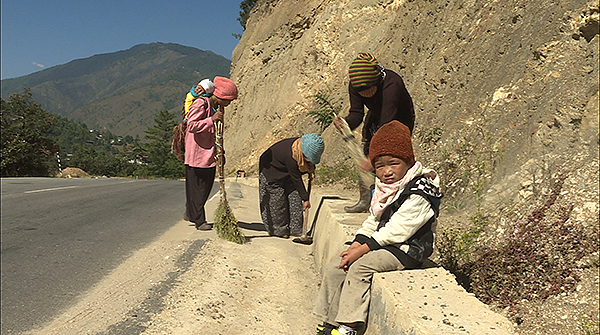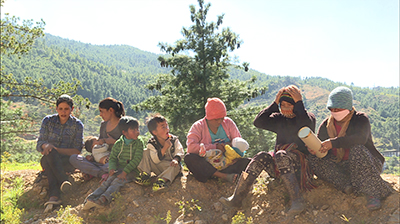
Six-year-old Kamal Rai spends his day on the roadsides every day. The little boy does this not out of choice but because he has no choice. Komal’s mother, Urmila Rai, is a road worker.
Kamal sits by the roadside playing as his mother works all day long. But Kamal is not alone. While there is no statistics available on the number of the children of road workers, there are thought to be hundreds of them.
Given a choice, these national force workers would like their children to be in a place better than the roadside. A childcare centre, for instance. “There is no one home home to look after the kids,” said Pabitra, a worker with the Lobesa Regional Camp.
“We don’t get time to interact with the kids,” said Chali Maya Gurung, another worker with the Lobesa Regional Camp.
“If there is a centre, it will be very beneficial for us. There will be people to care for our children at the centres. We can always go and pick them in the evening after work. If they start learning at an early stage, it will help them learn better as they grow.”
A study found roadside workers and their children to be one of the most vulnerable sections of the society. The parents work in harsh environment and their children grow up in the same environment and are deprived of proper nutrition, health care, growth stimulation and interaction. The study states such conditions in the early formation years can have adverse impacts on these children’s physical and mental health.
Apart from issues related to the growth and development of the children, there is also the issue of safety, which is no less a concern.
“It’s very difficult when we have to work carrying our babies because they are exposed to so much dust and there are also chances of road fatalities,” said Sancha Maya Tamang, a roadside worker based in Garpang in Bumthang.
“We have to keep moving from one place to another and it is challenging when you have your children accompanying you,” said Gopal Singh, also a worker based in Garpang, Bumthang.
“There are risks of children getting hit by cars. We cannot take care of them properly. We have to work in dust and the children fall ill. They learn nothing and it’s natural that they will end up like us.”
“It is difficult for both children and parents, especially mothers,’ said Surja Raj, a Supervisor of the Geytsa camp in Bumthang.
“It would be very helpful if there are ECCD centres where we can send our children during the day.”
Their wish does not seem far fetched. That’s because the works and human settlement ministry is planning to establish 12 Early Childhood Care and Development (ECCD) centres at 12 strategic camps along the north-east-west highway.
The prime minister, at the Meet the Press session last Friday, shared that the first strategic camp along with an ECCD centre will be set up soon. “We will see how that camp operates and how the ECCD in that camp operates and, then hopefully, in the next year or so, we would have established all 12 camps and with them 12 ECCDs,” said Prime Minister Dasho Tshering Tobgay.
In 2013, the Save the Children country office and education ministry carried out a feasibility study for ECCD programmes for the children of road workers. Based on a number of findings, the study recommended the Department of Roads of the works and human settlement ministry to establish ECCD centres.
The study also suggested a need for parenting education for the road workers to create awareness on the importance of the role of parents in the overall development of a child.
Research has proven that brain development is very rapid in the early years. But the Save the Children study states that workers are not aware of the importance of interaction and communication in stimulating early learning. They are also found to have very little knowledge about the benefits of different food and dietary requirements of a growing child.
Today, there are 2,234 national workforce workers across the country working under nine regional offices of the Department of Roads.










